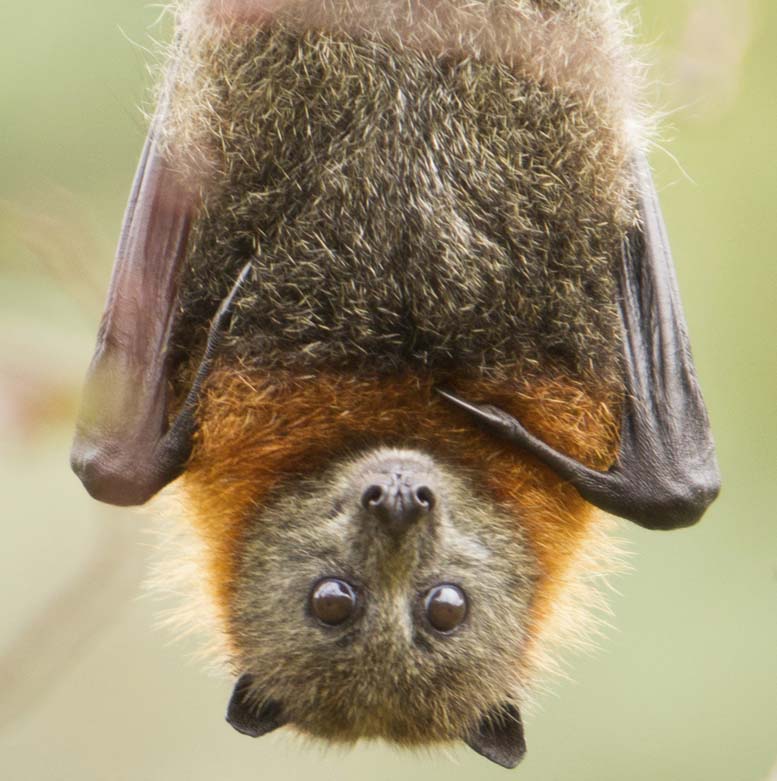A lot of people having been asking “Are bats to blame for our current COVID-19 crisis?” At the moment we don’t know – the animal source host (if there is one) for human COVID-19 virus remains obscure. Best guess is that the virus jumped into people from an animal associated with the huge live animal market trade in Wuhan, China. However, this is just a circumstantial assumption and we are still a long way from confirming or refuting this scenario – or for that matter, whether bats had any role in this process at all.
Why are bats so high on everyone’s hit list?
Bats have super immune systems that are constantly ‘switched on’. This allows them to live with viruses, including a number of coronaviruses, that can cause serious illness in other mammals. As bats were involved with the previous coronavirus SARS and MERS pandemics, investigators decided they were an obvious candidate and went on to compare bat coronaviruses and the COVID-19 DNA sequence in the hopes of getting a quick answer. Preliminary DNA sequence did confirm that COVID-19 is related to some of the known microbat coronaviruses – BUT the relationships discovered so far are not strong enough to confirm bats as the direct source host for this pandemic – the story is not quite that simple.
Bats (Microchiroptera) are part of the story with the original SARS-CoV pandemic in 2003 and also the subsequent MERS- CoV events from 2012 onwards. However in each case there appears to be another more proximate host in the transmission loop. With SARS-CoV the main culprit for viral transmission to humans was the palm civet (Parguma spp), an animal that is part of the Chinese live animal meat market; with MERS in the middle east, the main intermediate host is the dromedary (Camelus dromedarius). In each case, bats probably were the initial reservoir host for the ancestral coronavirus. At some point (who knows when) one of these ancestral viruses jumped out of a bat and into those intermediate hosts which then, after a period of adaptation, transmitted a novel more infective virus strain to humans, causing pandemic. Without the initial jump and adaptive step in the intermediate species the new human coronaviruses and subsequent pandemics would not have occurred. In the case of MERS-CoV, retrospective sample testing showed that camels had the virus for at least 30 years prior to the recognised human outbreak.
So are bats responsible for transmitting SARS and MERS to humans?
Or are the civets and camels respectively responsible?
In fact neither bats, camels or civets are to blame.
We humans are responsible – but we’ll leave the sledgehammers of that discussion for a later date.
Something like the SARS and MERS CoV transmission patterns may also be what happened with COVID-19 – although the jury is still out and it may be a while before we can muster enough resources to better answer the question. In mid-February preliminary DNA sequence comparisons suggested the pangolin (Philodota spp.) may have been the culprit intermediate species for COVID-19. Pangolins are bizarre and cryptic animals, widespread across Africa and Asia, and are yet another taxon group commercially ravaged and driven to near extinction by the Chinese traditional medicine and food culture. Initial concerns for pangolin involvement in COVID-19, however, were recently allayed when more comprehensive DNA sequencing subsequently showed only a moderate relationship between pangolin coronavirus and COVID-19.
So it’s back to square one.
Our COVID-19 is likely to have crossed into humans from close contact with an animal that is part of the live animal market trade in China as a result of highly specific circumstances. That animal in turn may have originally got the ancestral virus from microbats again under remote and highly specific circumstances. As soon as the human pandemic settles we may get the time and resource to figure out more clearly where COVID-19 came from.
But that’s not really the important question is it?
WHY did COVID-19 emerge and jump into humans at Wuhan in December last year? What ecological forces drove it to cross species in the first place? These are the crucial questions.
And the question on everyone’s lips Down Under – are our bats (microbats and flying-foxes) here in Australia likely to be a source of COVID-19?
Highly unlikely.
But it would be prudent at some time in the future to have a look and see what sorts of coronaviruses our bats may carry and assess and manage the risk of zoonotic coronavirus emergence here.


